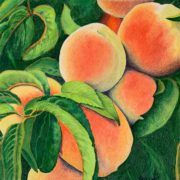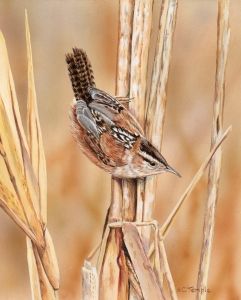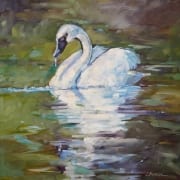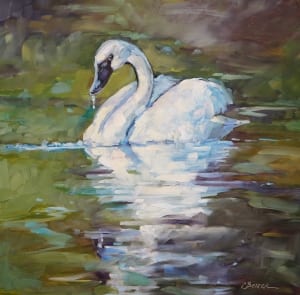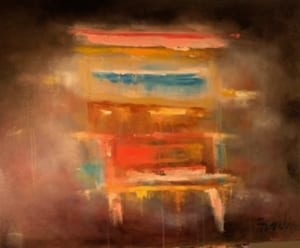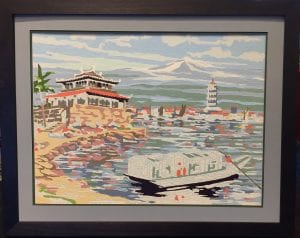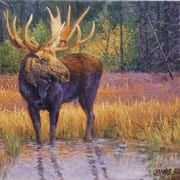Painting Beauty — The Artwork of Cheryl Bush

A blend of media, Peaches features colored pencil and watercolor. Original mixed media painting by Cheryl Bush.
There aren’t a lot of people who have talked to someone who has met Charlie Chaplin, but Cheryl Ann Bush is one of those people.
The Yakima, WA, artist, who creates artwork in colored pencil, oil pastel, watercolor, acrylic, and pen and ink, remembers the time she met her great-grandfather Herman Steuernagel at a family reunion.
“I was in grade school,” she says. “My great-grandfather was a well-known artist in Germany before retiring to New York in 1910. When he was in Germany, he had done background sets for the theater, and when he relocated to New York, he did background sets for the silent movies. During that time, he met Charlie Chaplin.”

Bush enjoys the incredible detail that working in colored pencil brings. Apples — Nature’s Beauties, original painting by Cheryl Bush.
As the art director of the Pathe Film Company from 1909 to 1917, Steuernagel sold his theater sets worldwide, but what excited the young Cheryl most was that he was a painter.
“It was so special to be able to meet and share my love of art with him,” she says.
Paintings on the Walls
Growing up in a house with lots of art on the walls (Bush’s great aunt, Alice Leo Oldright, was also an artist, a landscape and still life painter who lived in Walla Walla from 1900 to 1921 and later moved to Utah) Bush developed an appreciation for representational art, and regardless of the medium she chooses, she focuses on the essence of her subject matter. It does not matter whether she is painting a landscape in acrylic or a cluster of apples in colored pencil. Each medium has its advantages and disadvantages, and she immerses herself in the uniqueness of each.
“I enjoy the precise detail that can be obtained with colored pencil. It can be tedious and time consuming, but the results are well worth the effort.
“Combining watercolor with colored pen, I believe, gives award winning results, which they literally did with Still Life in Red, White, Blue. That included red petunias from our garden. It received Third for watercolor at the Western Washington State Fair.
“Vine Ripened and Peaches featured colored pencil along with watercolor which gave the results I was looking for.”
Every Painting Has a Story
Not only the medium used, nor subject matter, enhance the story of each artwork, Bush adds. During the process of creating the artwork, life happens, and those moments of life incorporate themselves, visually or metaphysically, into the finished piece. Bush recalls the time she was working on Hailey’s Dahlia, an oil pastel she focused on one summer.
“At the time, my daughter was expecting her first child, and she was two weeks late. I joked that she was waiting for grandma to finish her piece.
“The day after I finished the artwork Hailey was born, so I named the piece for her.”
As an added bonus, the painting was accepted into the South Sound Four League Art Exhibit in Tacoma, where it won the Tacoma Mayor’s award.
Another piece, a charcoal of Mount Rushmore, was accepted into the Puyallup State Fair, a fact about which Bush was happy because it was the first show in which she publicly exhibited her work. She was even happier, however, when the drawing sold.
“I was so surprised I borrowed a Polaroid camera to take a picture of it on the gallery wall so I could have it for a portfolio.”
A Light Happy Space for Painting
Retired from a career in education, Bush is grateful that she is no longer restricted to vacation breaks for working on her art. For years she set up her studio in a corner of the family room, but since moving to Yakima from Pierce County in 2014, she has worked out of a designated studio room in her house. Ledges on the wall hold finished paintings, and storage cabinets keep in one place all the accoutrements for artistic creativity. It is a light, happy space, and she spends many hours there. That happiness finds its way into her art.
“I believe that God has given us this beautiful world to enjoy, and I love to create works of art that reflect the beauty of His creation,” Bush says.
“It is rewarding when I can bring joy and a smile by bringing happy memories to mind with my work.”
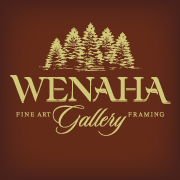 Cheryl Bush is the featured Art Event at Wenaha Gallery from May 10 through June 6, 2022.
Cheryl Bush is the featured Art Event at Wenaha Gallery from May 10 through June 6, 2022.
Contact the gallery, located at 219 East Main Street, Dayton, WA, by phone at 509.382.2124 or e-mail art@wenaha.com. Gallery hours are 9 a.m. to 5 p.m. from Monday through Friday, and by appointment. Visit the Wenaha Gallery website online at www.wenaha.com.

